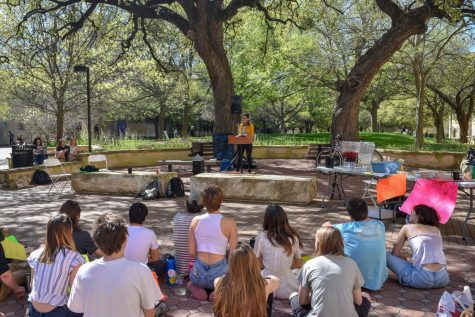Bomb scare at UT raises questions of campus safety
Imagine every St. Edward’s University student standing on the sidewalks of South Congress Avenue, waiting for the all-clear from administrators and police to re-enter campus after a bomb threat. Such a scene may be hard to imagine, but a similar scene was a reality for students at the University of Texas at Austin and two other universities on Sept. 14.
UT Austin received a call from a man claiming to be a member of al-Qaeda around 8:35 a.m. on Sept. 14. The man insisted that bombs would detonate throughout the UT campus in 90 minutes. Administrators took over an hour to alert more than 50,000 students and 22,000 faculty of the bomb threat, the Austin American-Statesman reported. A campus-wide evacuation was issued at 10:53 a.m. and continued until 1 p.m. after all buildings had been cleared.
After the incident, many people were upset with UT administrators’ decision to wait before alerting the school about the bomb threat. UT President Bill Powers insisted that they needed to evaluate the situation before taking any kind of drastic measure, but some students would have preferred more immediate updates, according to The Associated Press.
With the rise of social media, students now have a certain expectation of immediacy. Students are so readily connected to the world on their smartphones that they expect the same level of connectivity at school. They want to know what is happening at any moment and why it is relevant. So even if a mandatory evacuation was not enforced early on, a clear method of communication should have been established to reduce confusion.
On the same Friday that UT received its bomb threat, North Dakota University in Fargo, N.D. and Hiram College in Ohio received threats of their own, The Associated Press reported. Even though all three incidents ended peacefully, this raises the question of whether administrators should take violent threats more seriously.
Should administrators expect bomb threats to be fake? UT administrators’ delayed response to the Sept. 14 bomb threat indicates that administrators had their doubts about the threat’s validity, but the fact of the matter is that the bombs could have been real. Even if every bomb threat in the past has been fake, the potential damage done by an actual bomb should be enough to warrant a quick and serious response from administrators on any campus.
In the past, St. Edward’s has reacted quickly to bomb threats. In 2007, a series of bomb threats made to St. Edward’s were taken seriously, with the St. Edward’s University Police Department (UPD), the Federal Bureau of Investigation and the Austin Police Department conducting a thorough investigation.
Like the UT incident, the St. Edward’s bomb scare ended peacefully, but there was clear and immediate action. After the bomb threat, UPD insisted that security across campus would tighten to help to ease stress.
Overall, St. Edward’s has responded effectively to threats of violence in the past, and UPD continues to promote campus safety with its Emergency Response Guide, which outlines safety procedures, including those in place in case of a bomb threat. UPD has extensive safety resources available online.
In the case of a bomb threat, school administrators must react quickly and take the threat seriously. Even if most bomb threats are fake, there is always the risk of a real bomb being detonated on a college campus, and that is not a risk worth taking.


![According to a 1993 archive from Congressional Quarterly Almanac, “[Judge] Ginsburg was known as a restrained and fair-minded judge who did her homework and then some.” She was “considered moderate to conservative on criminal issues and business law,” relatively progressive “on issues such as free speech, religious freedom and separation of church and states,” and more liberal on “civil rights and access to the courts.”](https://www.hilltopviewsonline.com/wp-content/uploads/2020/10/VP-4RBG_CC-by-WFULawSchool-475x317.jpg)




